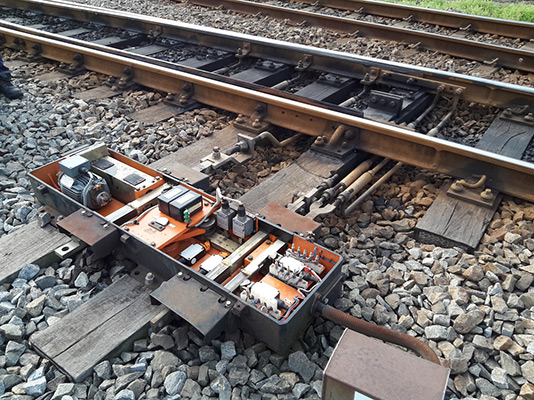Vesconite continues to be used by one rail component manufacturer, which has been using its products for more than 50 years.

A specialised Southern African railway signalling company, Actom Signalling, has found minimal wear in accelerated wear testing on the Vesconite slides that are contained in its point machines, which control railway tracks and switch the tracks that particular trains will be directed to.
This was confirmed by Actom Engineering Projects and Contracts Development Technician Wayne Meyer.
He notes that testing was carried out in November and December 2022 on a complete B1 Switchmatic Point Machine that was taken out of the production line for the express purpose of testing the performance of the point machine.
“We have to back our products so, periodically, we do these tests,” says Meyer.
“They provide comfort to our customers on the performance of our machines,” he notes of the tests that over a few days put a randomly-selected machine through its expected operating life.
More than 5,000 actuations, or movements of the point machine drive bar, were tested at the company’s factory in Germiston, South Africa.
Since Vesconite slides are among the components that are used on the machines, slide wear was also tested.
Vesconite slides are located around the detection, lock and drive bars at the point where they exit the points machine housing.
The point system blades and bars also run on a track of Vesconite so they are enclosed within Vesconite when they are within the point system housing.
Meyer notes that most of the wear was on the bottom Vesconite slides; this measured around 0.17 mm.
“This is very little for the amount of work that was done,” he says.
Wear on the top-most and side liners was almost undetectable, with wear of 0.05 mm being present, informs Meyer.
Point machines are critical in controlling the directional change of a train and for the safety of rail services.
Among the important components of the point machine are the detection blades, which determine the position of the right and left lines on the track; the locking blades, which physically locks the rail in place in a new position; and the drive slide, which is used to push the tracks into the correct position.
“With each actuation of the B1 Switchmatic point machine, the stroke of it is 300 mm, so there is 300 mm of movement over the Vesconite liner each time the machine will actuate,” describes Meyer.
“For the amount of wear, that is very good,” he says.
The B1 Switchmatic is Actom’s most popular point system, and is a well-tested machine that was first developed in the 1980s. It is the model on which Actom’s other point systems are based.
Actom has also developed the C1-H clamp lock point machine, the in-sleeper or integrated point machine, and the yard point machine — all of which include Actom’s important safety features and locking mechanism.
The C1-H is a smaller machine that was developed in the 2000s and is frequently used on passenger rails on which the rail tracks are normally located closer to one another than would be the case with freight rail.
The yard point machine is a robust, portable machine which is used in shunting yards and operated with high frequency.
The in-sleeper machine is Actom’s newest machine, which combats vandalism and theft by being small enough to be installed securely between the rails and inside the concrete sleepers.
All of the machines use Vesconite extensively, with some of the original machines still operating 40 or 50 years later with low-friction low-maintenance wear-resistant Vesconite still installed.
Contact:
Ronnie Mugisha
+27 11 616 1111
vesconite@vesconite.com
Tune in for a timely conversation with Susan Spence, MBA, the new Chair of the ISM Manufacturing Business Survey Committee. With decades of global sourcing leadership—from United Technologies to managing $25B in procurement at FedEx—Susan shares insights on the key trends shaping global supply chains and what they mean for the manufacturing outlook.